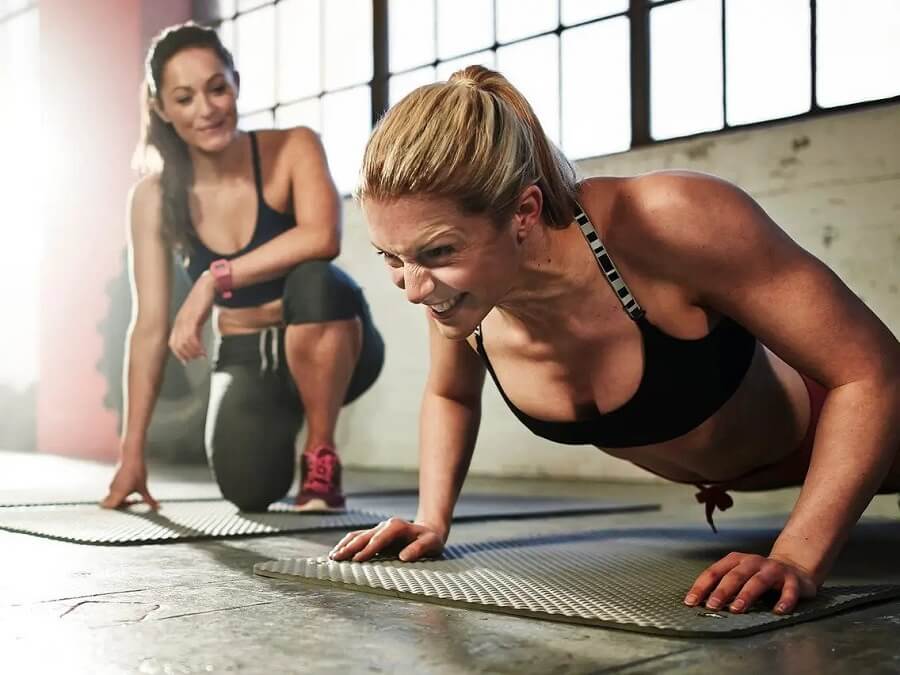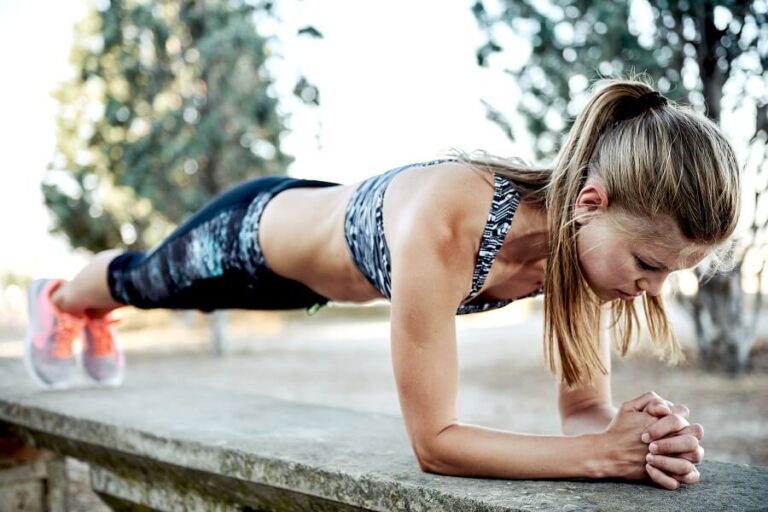Pushups, pushups, or pushups are one of the best chest exercises for beginners. The main advantage of pushups is that they can be done at any time and do not require special equipment, making them ideal for a home routine.
A pushup routine is an excellent method to build strength and achieve pectoral muscle hypertrophy in beginners. However, errors in technique can cause shoulder injuries and lower back pain.
This article describes the correct pushup technique for beginners and a routine to do at home with different types of pushups. The goal: achieve 100 reps.
How To Do Pushups – Correct Technique For Beginners
To do pushups correctly, the first thing a beginner should do is know how to position the hands and keep the body straight.
To do this, stand up straight, look at yourself in the mirror, put your hands against your body and bring them forward without turning your back. Repeat the movement about ten times. Once this feeling is achieved, you are ready to begin a pushup routine at home.
The step-by-step pushup technique is described below:
- Straight body
To do pushups correctly, you must keep your back straight. Don’t drop at the hips or lift your hips. You should form a straight line from head to toe. If you are a beginner and do not know how to do it, look in a mirror to see if your hips are aligned. The most awkward position is probably the correct one.
- Feet together
Many people do not care about their feet when doing pushups, which usually results in poor technique. When doing classic pushups, you should use both feet for support. Use your knees if you are a beginner and can’t handle the weight.
- Align your hands
When you place your hands on the ground, imagine an imaginary line between them and that your chest is floating on that line. If your hands are positioned too high (such as above your shoulders), your elbows will feel swaying, and you will not be able to support your body weight when you lower it. If your hands are too low, you will feel excessive tension in your shoulders.
- Width of the hands
When doing classic pushups, the hands’ width should be slightly more than the width of the shoulders. However, different variations can be made to work for other muscle groups. For beginners, it is recommended that the hands’ width be more significant; this allows to work more on the chest and less on the triceps.
- Look at the ground
Before going down, make sure you’re looking at the ground when doing pushups. It would help if you looked slightly forward than your head. This position keeps your spine more aligned and, at the same time, enables you to breathe better.
- Down
How far down to go with the pushups? The most accessible rule of thumb for how far down is to keep your chest one finger off the ground. It doesn’t have to be exact, but make sure you feel tension on the sides of the trunk where it connects with the shoulders.
If it has not been clear to you, you can see the following video on how to do pushups:
Example of a pushup routine to do at home
Routines like the “100” pushups in 3 weeks have been published in some sports magazines. These routines and plans based on a maximum number of pushups in a short period seek to stimulate obsession in beginners.
These types of routines are not the most recommended for beginners. Even less if they are considered a routine for beginners without experience in the sport, they can lead to overtraining, lower back injuries, and loss of continuity in physical exercise in the long term.
At Nutrition 360, we propose adopting a pushup routine at home based on your progress. The idea is to achieve 100 repetitions with a whole emphasis on technique.
If a beginner finds that the muscles cannot get into the set routine, it is better to reduce the repetitions per exercise (or repeat more specific types of pushups) than sacrifice the technique. To make it simpler, in the routine, we order the types of pushups by difficulty.
Below you can see an example of a pushup routine to do at home:
- Pushups on knees
Ten reps
- Classic pushups
Ten reps
- Diamond pushups
” alt=”” aria-hidden=”true” />
10 reps
- Inclined diamond push-ups
10 reps
- Incline open pushups
10 reps
- Pushups with a fist
10 reps
- Pushups on a support
10 reps
- Cross-leg pushups
10 reps
- Inverted pushups
10 reps
- Jump pushups
10 reps
How many times to do a pushup routine at home per week?
How many times you will do a pushup routine at home depends on the goals you set for yourself.
For the chest muscles to increase their volume, it is recommended that a beginner does not exceed the number of 100 repetitions. This is doing ten sets of 10 repetitions; the rest should be 1 minute.
If the difficulty is low, you can do the more difficult pushups, for example, on a support or with a jump.
On the other hand, if you have already worked your chest with exercises such as the flat chest press or parallel bar dips, Doing pushups can be used as an active recovery method. In these cases, more than 50 pushups per day are not recommended.
Some coaches recommend doing pushups after 6-8 reps of a chest workout with barbells or heavy loads. In this way, it is possible to increase the blood supply to the pectorals.
If you are an advanced athlete, below you can see an example of how to do the series, repetitions, and rest days in a pushup routine:
| Day 1 60 sec rest between sets | |
| Serie 1 | 10 |
| Serie 2 | 13 |
| Serie 3 | 11 |
| Serie 4 | Maximum possible repetitions (minimum 13) |
| Minimum rest 2 days | |
| Day 2 90 seconds between sets | |
| Serie 1 | 11 |
| Serie 2 | 14 |
| Serie 3 | 12 |
| Serie 4 | Maximum possible repetitions (minimum 14) |
| Minimum rest 2 days | |
| Day 3 120 seconds between sets (or more) | |
| Serie 1 | 12 |
| Serie 2 | 15 |
| Serie 3 | 13 |
| Serie 4 | Maximum possible repetitions (minimum 15) |
| Minimum rest 3 days |
Benefits of pushups
One of the benefits of pushups is that this exercise does not require any equipment. If you know how to do pushups correctly, you can do them at home or on vacation.
In this exercise, you work the upper body and the abdomen simultaneously. So if your goal is to tone and strengthen the upper body, it is ideal.
Another benefit of pushups, as with the barbell deadlift, is to work several muscle groups and common areas simultaneously. This allows you to expend large amounts of energy and improve the cardiovascular system.
The benefits of a pushup routine at home are:
- Strengthen the core
- Improve the cardiovascular system
- Tone the chest muscles and triceps
- Improves the flow of fluids to the upper body muscles
Types of pushups: What muscles do they work?
The work of the muscles depends on the type of pushups that are executed. For example, classic pushups primarily target the major pectoral muscles; to a lesser degree, the triceps, abdomen, and back muscles are worked.
Different load distribution is achieved when doing other types of pushups, such as changing inclination.
By resting the feet on a platform, a beginner can work the muscles of the upper chest area more. It is possible to perform the lower chest area more by supporting the arms.
The hands should be spread widely (wide opening flexion ). There are two types to focus on the triceps: the narrow opening pushups and the elbows next to the body. Or the diamond pushups: the hands are placed one with the other to form a rhombus.
If these types of exercises are also carried out in the form of static exercises, it is a way to improve the indicators of muscular strength.
A beginner pushup routine at home should not focus on doing all the more complex types and variations but on achieving the perfect movement technique. On the other hand, if you are an advanced athlete, you can do the most difficult pushups; on the fists, you can strengthen your wrists.
How much weight do you lift when doing pushups?
Research from the Journal of Strength and Conditioning Research states that; when doing classic pushups, the pectorals are worked with 64% of the body weight. 49% of the weight is in the case of the supported knee pushup type. (1)
If the bodyweight is 70 kg, they will be lifting 35 kg with supported knees and 45 kilograms in the classical technique. Although it is usually less than doing chest exercises at the gym, it is a considerable weight to be a routine at home.
Including different types of pushups or reducing the supports is one way to increase the weight on the chest even more.
How to gain weight when doing pushups?
The easiest and most practical way to gain weight when doing pushups is to put a base on your feet. Studies affirm that with a base of 60 cm high under the feet, the weight is increased by up to 75% of the percentage of the body weight. (1)
Another strategy to increase the weight in pushups is to do pushups on the one hand. If you want to work more on the middle zone, you can alternate lifting one leg and the other in each flexion. An exclusive method for advanced athletes is to do pushups with additional weight (in the form of discs) on the back.
Doing disk pushups is not as easy as it sounds. It is possible only with the help of a partner or personal trainer. Its lack of practicality does not make it a frequent exercise of choice in a pushup routine to do at home. If you are one of the lucky ones who trains accompanied and you see an advance in the strength of your pectorals, do not hesitate to test it.
ABSTRACT
Pushups are an excellent exercise to tone your pecs. The first rule of thumb for correct pushups is to keep your midsection firm, respect the shoulder-arm angles, and look slightly forward.
This exercise can be considered an essential chest exercise when starting the gym. Just as doing pushup routines is a way to maintain muscles from home.
A pushup routine at home should emphasize technique. To achieve 100 repetitions, a beginner is recommended to divide the pattern into ten sets.
The main benefits of pushups are that they do not require equipment, as well as allow several muscle groups to be worked simultaneously—something ideal for a beginner.
Including pushups between breaks from a 3-day-a-week gym, the routine stimulates blood circulation and improves chest shape.







